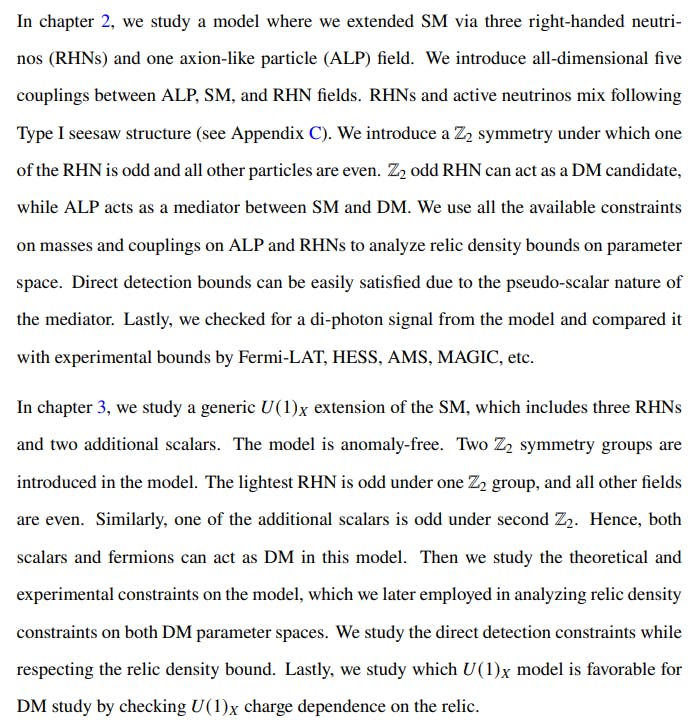An Outline of the Dark Matter Thesis
Table of Links
Acknowledgements
1 Introduction to thesis
1.1 History and Evidence
1.2 Facts on dark matter
1.3 Candidates to dark matter
1.4 Dark matter detection
1.5 Outline of the thesis
2 Dark matter through ALP portal and 2.1 Introduction
2.2 Model
2.3 Existing constraints on ALP parameter space
2.4 Dark matter analysis
2.5 Summary
3 A two component dark matter model in a generic 𝑈(1)𝑋 extension of SM and 3.1 Introduction
3.2 Model
3.3 Theoretical and experimental constraints
3.4 Phenomenology of dark matter
3.5 Relic density dependence on 𝑈(1)𝑋 charge 𝑥𝐻
3.6 Summary
4 A pseudo-scalar dark matter case in 𝑈(1)𝑋 extension of SM and 4.1 Introduction
4.2 Model
4.3 Theoretical and experimental constraints
4.4 Dark Matter analysis
4.5 Summary
5 Summary
Appendices
A Standard model
B Friedmann equations
C Type I seasaw mechanism
D Feynman diagrams in two-component DM model
Bibliography
1.5 Outline of the thesis
To explain DM, we introduce a few simple WIMP models that can bypass present constraints and have observable signatures in the future. The main challenge in any WIMP-like DM model is to explain relic density and stringent direct detection bounds simultaneously. In later chapters, we describe a few models to counter these challenges.
In this chapter 4, we have the particle and symmetry content similar to our previous model described in chapter 3, but with no Z2 symmetry. The U(1)𝑋 symmetry breaking results in a massive pseudo-scalar particle, which is the proposed candidate for dark matter. We study the parameter space where this massive pseudo-scalar particle has a lifetime much larger than the age of the universe. We constrain the allowed parameter space by the lifetime bound using perturbative unitarity, invisible Higgs width, and relic density bounds. The main advantage of having a pseudo-scalar DM is that it implies a vanishing scattering amplitude for direct detection at tree level in a non-relativistic limit. However, the one-loop level contribution could be finite, which we have studied and plotted against the current direct detection bounds.
Author:
(1) Shivam Gola, The Institute of Mathematical Sciences, Chennai.
